Art History
A Brief, Fluttering History of Butterflies in Art, From Symbols of Regeneration to Reminders of the Fleetingness of Life
With the dawn of spring, we take a closer look at the symbolism of butterflies, across the centuries.
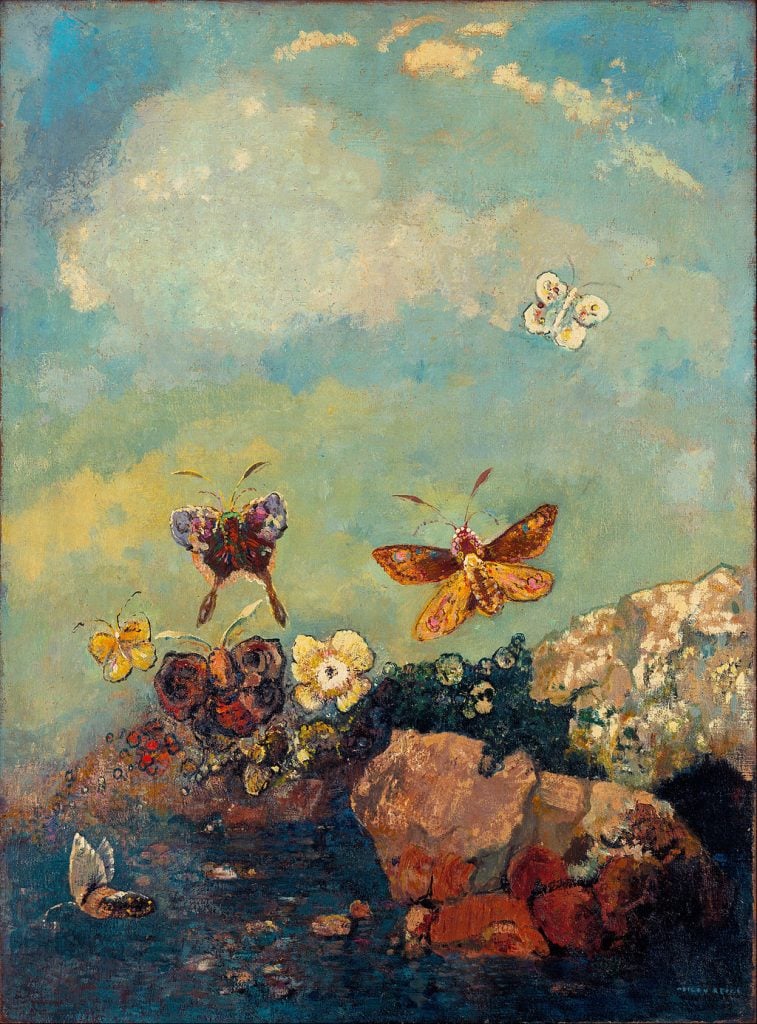
With the dawn of spring, we take a closer look at the symbolism of butterflies, across the centuries.

Katie White

“Everyone’s frightened of glass, everyone’s frightened of sharks, everyone loves butterflies,” Damien Hirst said in explanation of his frequent incorporation of the elegant winged creatures into his compositions.
Butterflies appeared early in Hirst’s career, with his work In and Out of Love (1991), which invited viewers to bear witness to the fleeting beauty of butterflies’ lives by watching them emerge from cocoons, live, and die within the course of the exhibition.
Later, in his work I am Become Death, Shatterer of Worlds (2006), the artist incorporated nearly 3,000 sets of butterfly wings into a kaleidoscopic image.
While Hirst may be the most famous contemporary artist to employ butterflies within his work, the insect’s symbolic import dates back to ancient times. They have been employed as vivid symbols of death and resurrection, the fleeting nature of beauty, and even as symbols of marriage in cultures around the world.
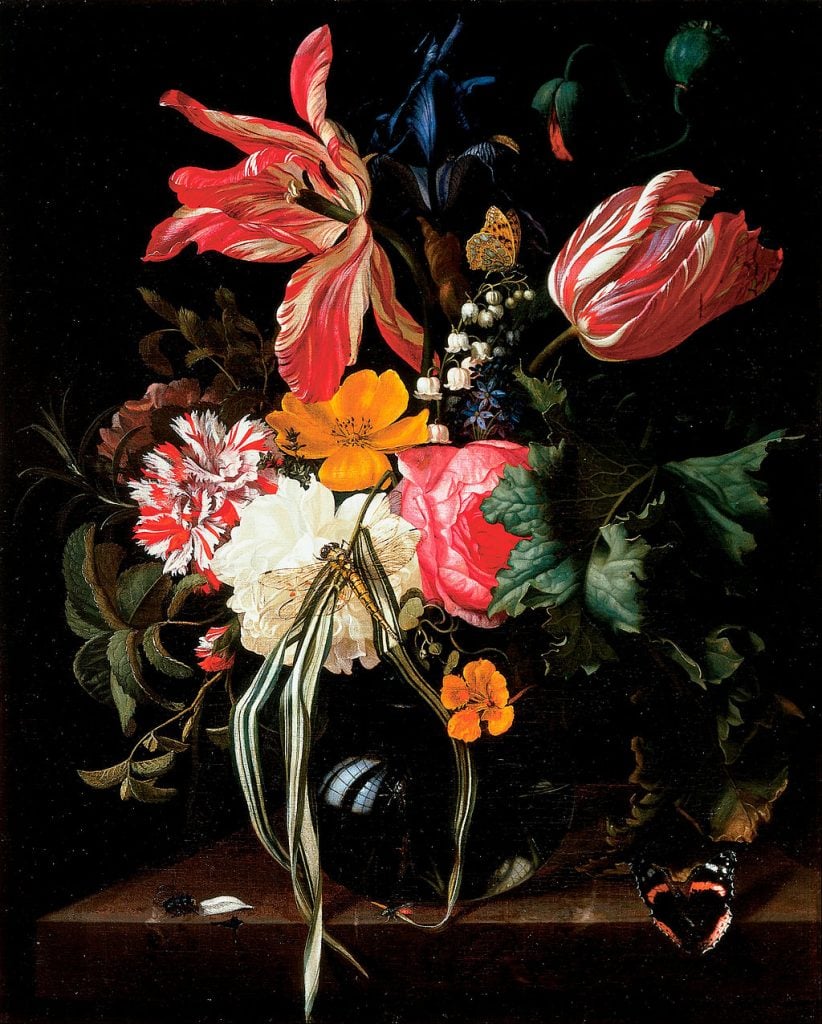
Maria van Oosterwijck, Flower Still Life (1669). Courtesy of Cincinnati Art Museum.
Butterflies, with their colorful and intricate wings and oh-so-brief lifespans, lasting but a few weeks between spring and early summer, have understandably come to symbolize life’s ephemerality.
Dutch Golden Age painter Maria van Oosterwyck was famed for vanitas paintings, which remind viewers of the impermanence of worldly luxuries and the eternal nature of the soul.
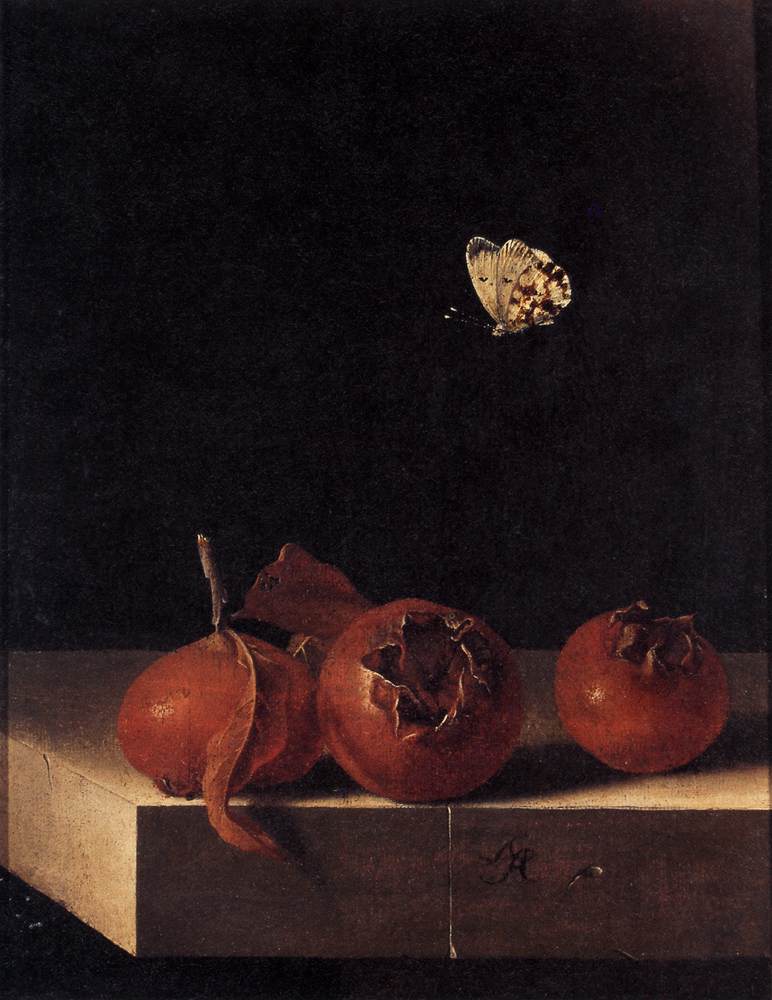
Adriaen Coorte, Three Medlars with a Butterfly (circa 1705)
Oosterwyck was also famed for her frequent inclusion of Red Admiral butterflies into her most significant paintings. Scholars believe these butterflies were her own unique symbol of Christ’s resurrection and the promise of eternal life. The metamorphosis of a caterpillar into a cocoon, emerging as a butterfly, symbolically mirrored the life, death, and resurrection of Jesus.
Here, the red and white of the butterflies’ wings symbolized Christ’s bodily sacrifice, and white, the Holy Spirit. Oosterwyck wasn’t the only artist to favor butterflies during the Dutch Golden Age: contemporaneous still life painters, including Adriaen Coorte and Rachel Ruysch, were also known for their bountiful depictions of butterflies.
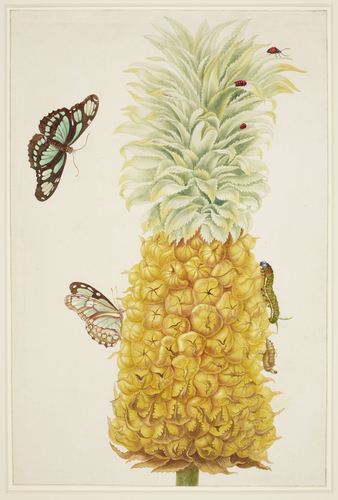
Maria Sibylla Merian, Pineapple (Ananas comosus) with the life cycle of a Dido Longwing Butterfly (Philaethria dido). Collection of the Royal Trust.
In the 17th and 18th centuries, amid the heights of European colonialism, artists and naturalists around the world set out to detail the flora and fauna of hitherto free lands. Many of these images, though ostensibly scientific, are informed by the artistic tastes and cultural beliefs of the artists’ homelands—which is certainly the case when it comes to their depictions of butterflies.
Much in the same way that still life artists of the age incorporated butterflies hovering around bouquets of flowers, naturalist Maria Sibylla Merian, too, included the insects in her illustrations of the flora she discovered while traveling in Suriname in 1699. Her illustrations were popularized in Metamorphosis Insectorum Surinamensium, a coveted volume which brought the splendors of Suriname’s natural landscape to Europe—including many new varieties of moths and butterflies.
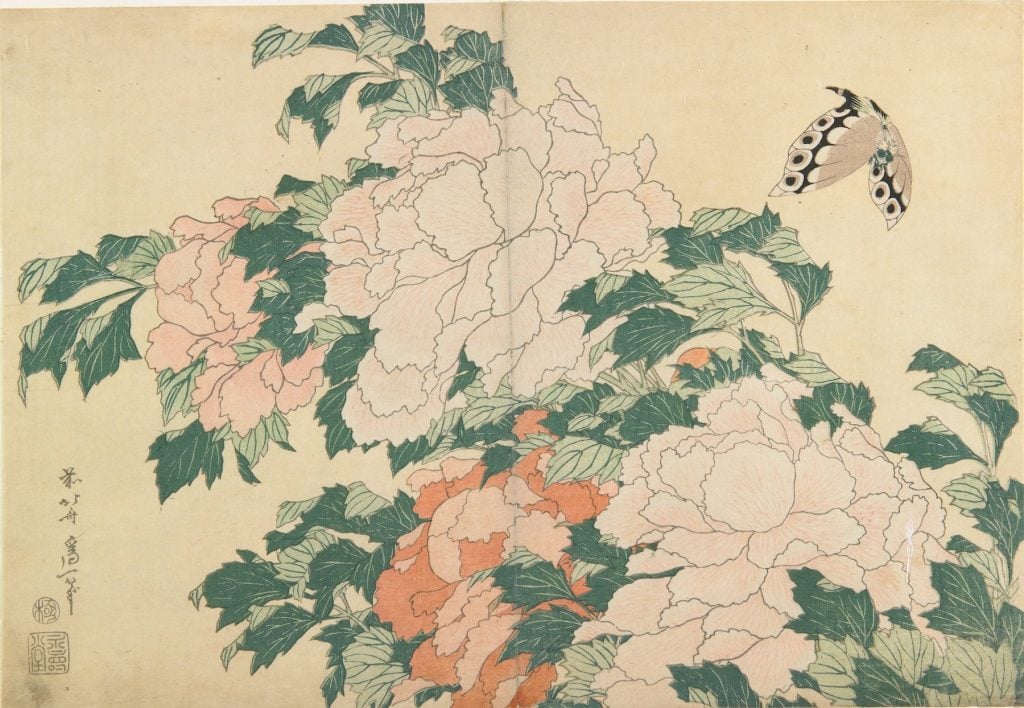
Katsushika Hokusai, Peonies and Butterfly (1833–34). Collection of the Minneapolis Institute of Art.
In Japan, the butterfly has a rich symbolic history, appearing on family crests, in origami, on kimono designs, and in ukiyo-e woodblock prints of the Edo era. A symbol of the transition from girlhood to womanhood, butterflies are also tied to many aspects of female ritual and experience.
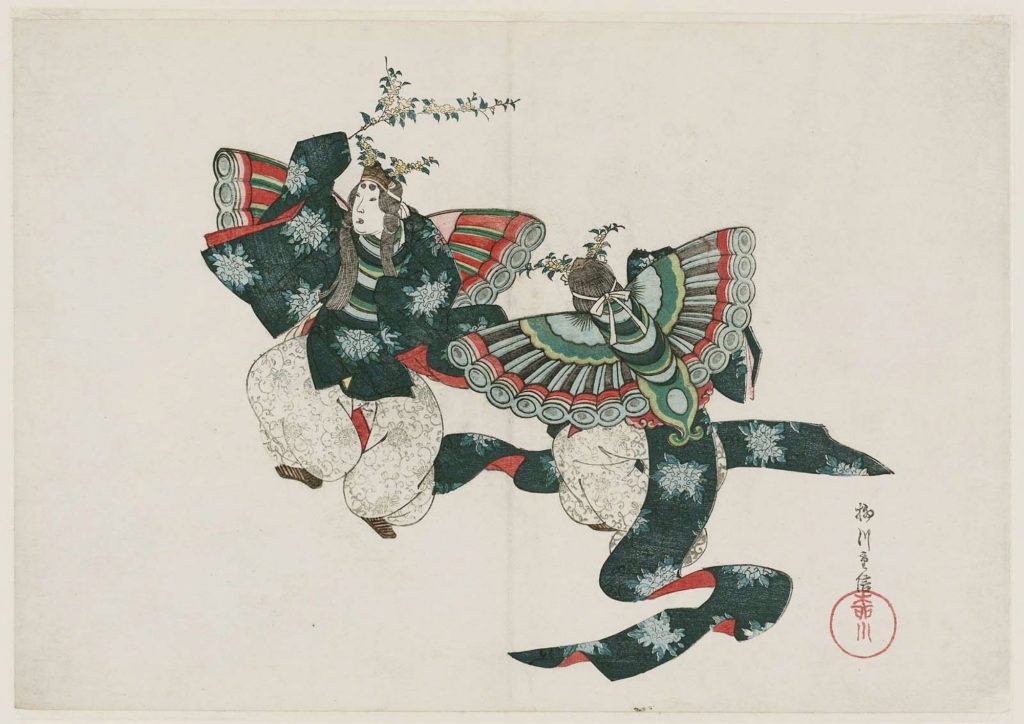
Yanagawa Shigenobu I, Two Dancers in Butterfly Costumes (circa 1820s). Collection of the Philadelphia Museum of Art.
The art of origami emerged in Japan in the 1600s; by 1680 the poet Ihara Saikaku famously wrote of a dream of paper butterflies. In Japanese wedding ceremonies, two types of origami butterflies, called Mecho (symbolizing the female) and Ocho (symbolizing the male) are symbolically placed on sake bottles.
While paintings of butterflies date back almost a thousand years in Japan, butterflies became an especially popular subject for the ukiyo-e woodblock prints in images that detailed the intimate lives of courtesans and performers. Depictions of butterflies were made by famous Edo artists including Utagawa (Ando) Hiroshige and Yanagawa Shiganobu, who often depicted dancers in butterfly costumes. Among the most famous of these depictions was Katsushika Hokusai’s Peonies and Butterfly, of which Claude Monet owned a print, which he kept with him at Giverny.
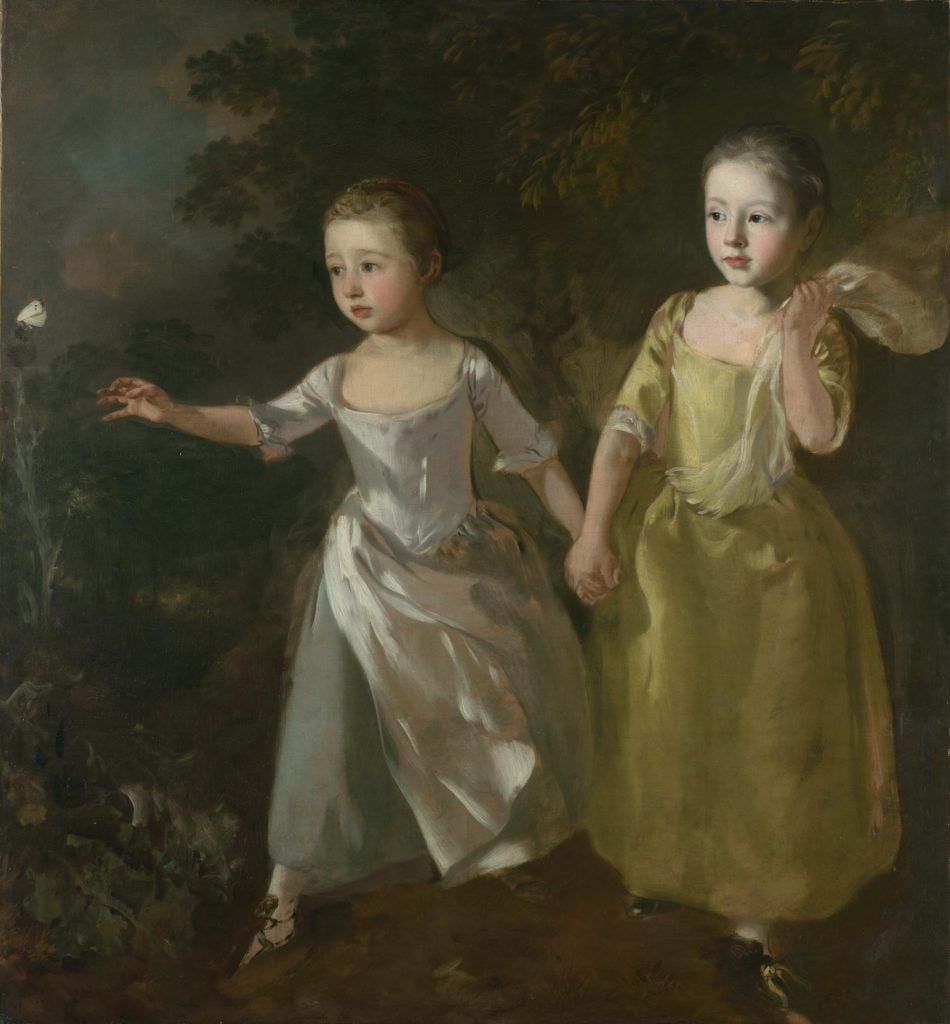
Thomas Gainsborough, The Painters Daughters Chasing Butterfly (1756). Collection of the National Gallery.
The fragility and beauty of butterflies—as well as their natural habitats—have informed more recent symbolic uses of the insects in art. As early as the late 18th century, artists were contemplating the consequences of the Industrial Revolution, both on the environment and on existing ways of life. Thomas Gainsborough’s painting The Painter’s Daughters chasing a Butterfly (1756) shows the artist’s two young daughters chasing a butterfly that rests on a prickly thistle. The butterfly, here, is a harbinger of coming dangers, while simultaneously acting as a symbol of hope, embodied in the promise of the young girls.
In later Impressionist paintings, including Seurat’s A Sunday Afternoon on the Island of La Grande Jatte, butterflies can be seen floating around scenes of middle-class leisure—leisure itself enabled by the Industrial Revolution. Believe it or not, the sooty-looking wings of peppered moths are an adaptation to pollution during the Industrial Revolution in England.
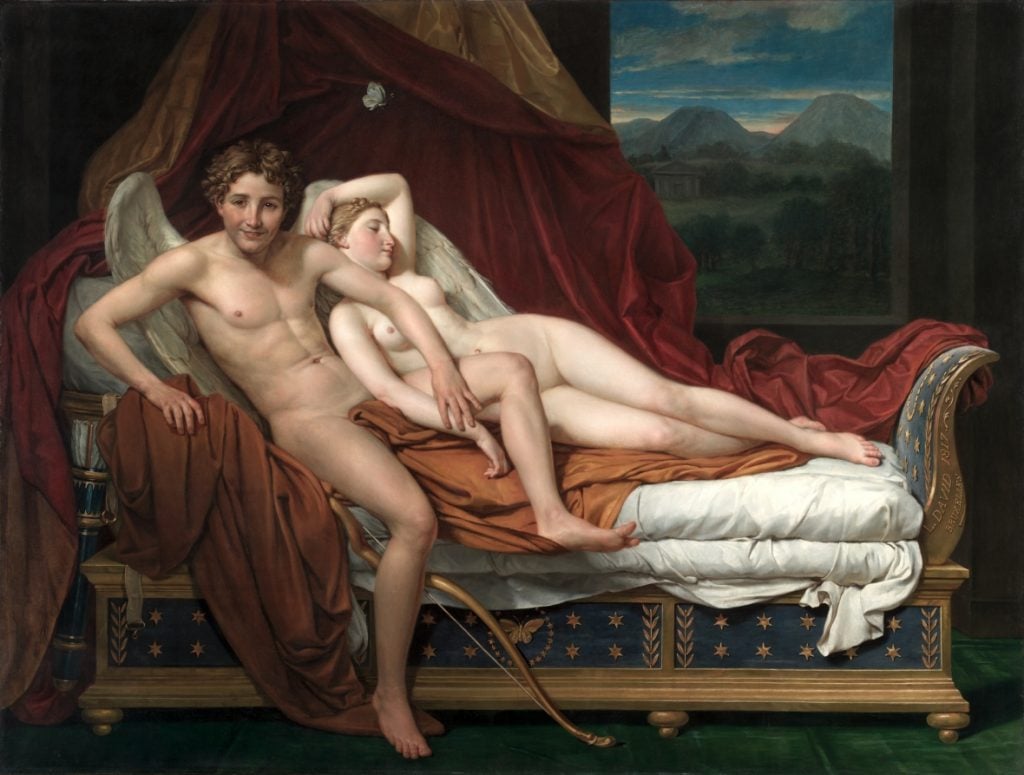
Jacques-Louis David, Cupid and Psyche (1817). Courtesy of the Cleveland Museum of Art.
In ancient Egyptian mythology, the butterfly was first associated with the transcendence of the soul. This belief was further shaped by the ancient Greeks, who cemented the association quite literally.
In Greek, psyche is the word for both butterfly and soul, and depictions of the goddess of the same name often include butterflies for this reason.
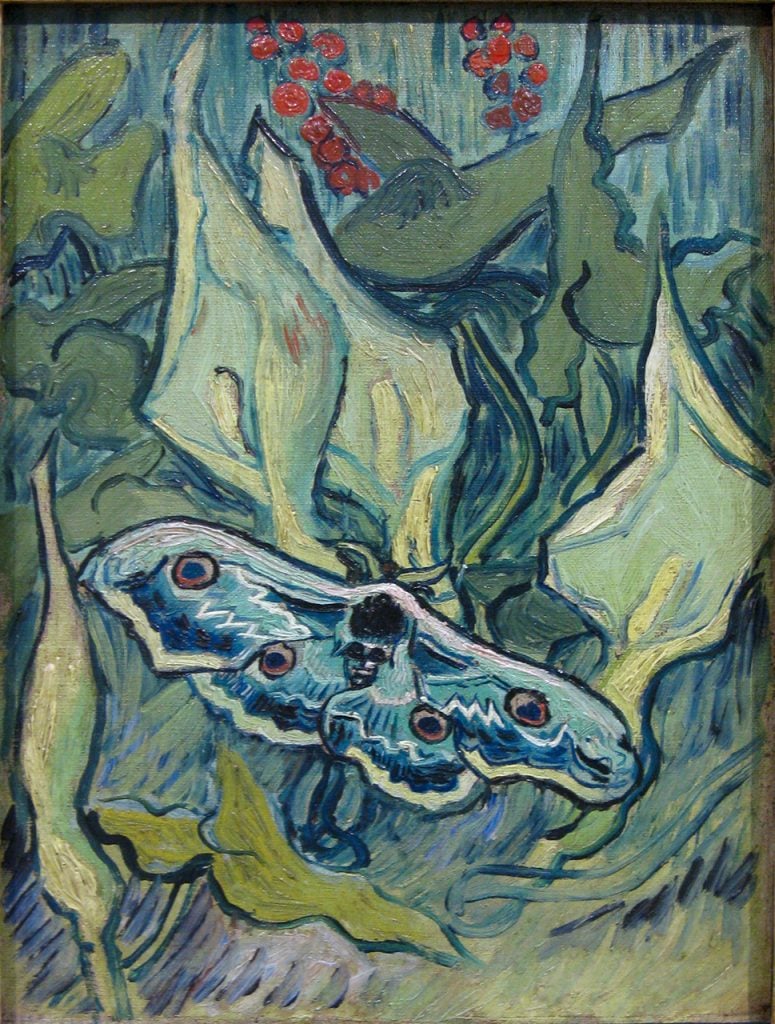
Vincent van Gogh, Great Peacock Moth (May 1889).
These ancient cultures underscored the transcendent aspects of a butterfly’s existence. This association has intrigued artists into the modern age. The Symbolist artist Odilon Redon, for instance, included butterflies along with shells and flowers as natural objects that could inspire the sense of wonderment and otherworldliness that art was capable of inducing. Van Gogh devoted an entire series to butterflies, seeing in them the promise of men and women’s abilities to change their lives and the existence of a better reality ahead.
In perhaps the most profound instance, Frida Kahlo’s Self Portrait with Thorn Necklace and Hummingbird (1940) presents the artist crowned by butterflies. The blue wings rest delicately on her hair. This halo of butterflies has been interpreted by scholars as symbolic of Kahlo’s own rebirth following a bus accident that had nearly killed her in her youth. Butterflies, in this case also suggest the possibility of near resurrection.